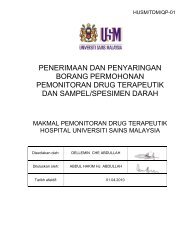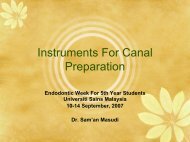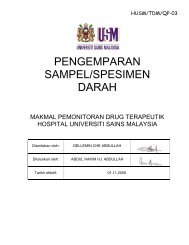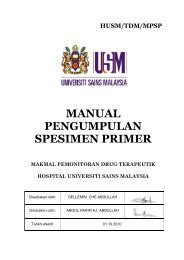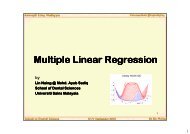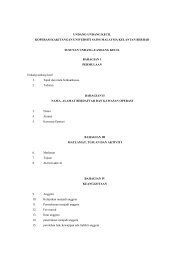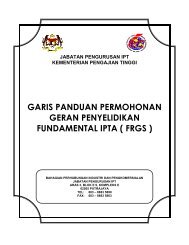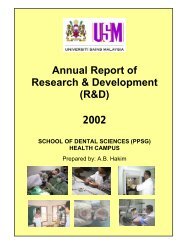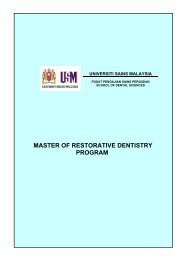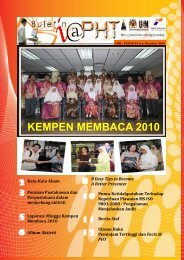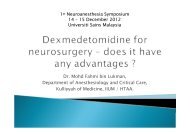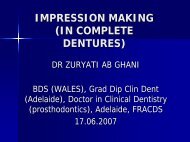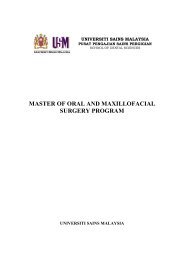Vol 11-R2- Eyelid
Vol 11-R2- Eyelid
Vol 11-R2- Eyelid
Create successful ePaper yourself
Turn your PDF publications into a flip-book with our unique Google optimized e-Paper software.
SRPS • <strong>Vol</strong>ume <strong>11</strong> • Issue <strong>R2</strong> • 2010<br />
functions to convert the anterior-posterior pulling<br />
force of the levator to a superior-inferior direction,<br />
which raises and lowers the eyelid. 21−23 The levator<br />
aponeurosis joins the orbital septum above the<br />
superior border of the tarsus and sends fibrous<br />
strands between the orbicularis oculi muscle septa<br />
to the skin to make the lid crease. 22 The normal<br />
excursion of the levator muscle is 15 mm. 3<br />
Müller muscle is a smooth, sympathetically<br />
innervated muscle in the upper eyelid. It originates<br />
from the undersurface of the levator muscle 8 to 10<br />
mm above the superior tarsal border and attaches<br />
to the superior edge of the tarsus. 22 It functions to<br />
provide 2 mm of lid retraction, and its interruption<br />
in Horner syndrome causes mild ptosis. 24<br />
Kakizaki et al. 25 found that the levator<br />
aponeurosis has doubly stratified layers that include<br />
smooth muscle. The authors suggested that the<br />
levator aponeurosis regulates tension in the anterior<br />
lamella of the upper eyelid as the Müller muscle<br />
regulates the tension of the posterior lamella of<br />
the upper eyelid. 26 The structures lead to ordered<br />
movement in the upper eyelid.<br />
Lower <strong>Eyelid</strong> Retractors<br />
In the lower eyelid, the retractors originate from<br />
the capsulopalpebral head of the inferior rectus<br />
muscle. The capsulopalpebral fascia is analogous to<br />
the levator in the lower eyelid. The capsulopalpebral<br />
head splits around the inferior oblique muscle<br />
and fuses again to form Lockwood ligament<br />
(similar to Whitnall ligament in the upper lid).<br />
The inferior tarsal muscle is a sympathetically<br />
innervated muscle analogous to Müller muscle of<br />
the upper lid. It originates on the posterior surface<br />
of capsulopalpebral fascia. The inferior tarsal muscle,<br />
capsulopalpebral fascia, and orbital septum insert at<br />
a fusion point into the anterior and inferior surface<br />
and base of the tarsus. 22 The capsulopalpebral<br />
fascia sends anterior projections that penetrate<br />
through the orbicularis to the skin to create a<br />
transverse crease. 3<br />
Preaponeurotic Fat<br />
The preaponeurotic fat serves as an important<br />
6<br />
structure in eyelid anatomy. It is a crucial surgical<br />
landmark. The levator aponeurosis lies just posterior<br />
to the preaponeurotic fat, and the septum lies<br />
just anteriorly. In the upper eyelid, two fat pads<br />
are found: the nasal and middle fat pads (Fig. 5).<br />
The nasal fat pad lies beneath the trochlea. The<br />
lower eyelid has three fat pads. The nasal fat pad is<br />
separated posteriorly from the central fat pad by the<br />
inferior oblique muscle. The central and lateral fat<br />
pads are connected in deeper layers but anteriorly<br />
are divided into two pads by a dense septal<br />
partition. 22 The nasal fat pads are distinctly whiter<br />
in color in both the upper and lower eyelids when<br />
compared with the yellow color of the more lateral<br />
fat pads.<br />
Medial Canthus<br />
The medial canthus provides a support point for the<br />
eyelids, helps provide its normal angular shape, and<br />
assists the lacrimal pump apparatus. 27 It is rigidly<br />
fixed to the orbital wall.<br />
McCord et al. 22 illustrated the structure of<br />
the medial canthus and reported that medially, the<br />
pretarsal orbicularis produces two heads that pass<br />
superficial and deep to the canaliculi. The anterior,<br />
more superficial, pretarsal orbicularis muscle forms<br />
the anterior crus of the medial canthal tendon that<br />
inserts into the frontal process of the maxillary<br />
bone. The posterior, deeper, pretarsal orbicularis<br />
inserts into the posterior lacrimal crest. The muscle<br />
is known as Horner muscle. The deep pretarsal<br />
orbicularis inserts on the posterior lacrimal crest<br />
and the lacrimal fascia. The deep preseptal fibers<br />
insert mainly on the lacrimal fascia, and this is<br />
known as Jones muscle. The preseptal muscle forms<br />
the horizontal raphe laterally, and medially, it inserts<br />
into the anterior crus of the medial canthal tendon.<br />
Lateral Canthus<br />
The lateral canthal tendon resembles the medial<br />
canthal tendon in that it supports the lids by<br />
supplying a tendinous attachment of pretarsal<br />
orbicularis oculi muscle and ligamentous<br />
attachment of the tarsal plates to the periosteum<br />
of the lateral orbital tubercle. It also allows



